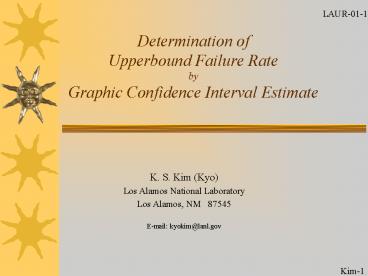Determination of Upperbound Failure Rate by Graphic Confidence Interval Estimate - PowerPoint PPT Presentation
1 / 14
Title:
Determination of Upperbound Failure Rate by Graphic Confidence Interval Estimate
Description:
LAUR-01-1671 Determination of Upperbound Failure Rate by Graphic Confidence Interval Estimate K. S. Kim (Kyo) Los Alamos National Laboratory Los Alamos, NM 87545 – PowerPoint PPT presentation
Number of Views:62
Avg rating:3.0/5.0
Title: Determination of Upperbound Failure Rate by Graphic Confidence Interval Estimate
1
Determination ofUpperbound Failure
RatebyGraphic Confidence Interval Estimate
LAUR-01-1671
- K. S. Kim (Kyo)
- Los Alamos National Laboratory
- Los Alamos, NM 87545
- E-mail kyokim_at_lanl.gov
Kim-1
2
If you believe that selecting Power Ball
numbersis a random process, that is, a Poisson
process,then your chance of winning is 1 in
1000000. But considering your horoscope today
and invokingthe Bayesian theorem, your chance
can be 1 in 5.Of course, there are sampling
errors of plus-minus.
Gee, I wonder whatis the odd of gettingmy money
back
Kim-2
3
DOE Hazard Analysis Requirement
LAUR-01-1671
- DOE Order 5480.23 requires Hazard Analysis for
all Nuclear Facilities - Hazard Analysis entails estimation of Consequence
and Likelihood (or Frequency) of potential
accidents - Potential Accidents are Binned according to
Consequence Frequency for determination of
further analysis and necessary Controls - DOE-STD-3009 provides Example for Binning
- LANL Binning Matrix (risk matrix)
Kim-3
4
LANL Binning Example
LAUR-01-1671
Kim-4
5
Method for Frequency Determination
LAUR-01-1671
- Historical Record of Event Occurrence (number of
events per component-time or N/CT) - A simple division of N/CT ignores uncertainty (1
event in 10 component-yrs and 100 events per
1,000 component-yrs would be represented by the
same frequency value of 0.1/yr) - Not useful for a type of accident that has not
occurred yet (Zero-occurrence events) - Fault Tree/Event Tree Method (for PRA) can be
used for Overall Accident Likelihood Historical
record is used for estimation of initiating event
frequency or component failure rate/frequency
Kim-5
6
Statistical Inference Primer
LAUR-01-1671
- Typical occurrences of failure (spill, leaks,
fire, etc.) are considered as random discrete
events in space and time (Poisson process), thus
Poisson distribution can be assumed for the
Failure Rate (or Frequency) - Classical Confidence Intervals have the property
that Probability of parameters of interest being
contained within the Confidence Interval is at
least at the specified confidence level in
repeated samplings - Upperbound Confidence Interval for Poisson
process can be approximated by Chi-square
distribution function - ?U (1-P) is upper 100(1-P) confidence limit
(or interval) of ?, - P is exceedance probability,
- ?2(2N2 1-P) is chi-square distribution with
2N2 degrees of freedom
Kim-6
7
Chi-square Distribution
LAUR-01-1671
Kim-7
8
Graphic Method
LAUR-01-1671
- Zero-occurrence Events
- Nonzero-occurrence Events
Kim-8
9
Zero-occurrence Events
LAUR-01-1671
Kim-9
10
Nonzero-occurrence Events
LAUR-01-1671
Kim-10
11
Examples
LAUR-01-1671
- Upperbound frequency estimate of a liquid
radwaste spill of more than 5 gallons for a
Preliminary Hazard Analysis (desired confidence
level is set as 80 or exceedance probability of
0.2). No such spill has been recorded for 3
similar facilities in 10 years. - Upperbound frequency estimate of a fire lasting
longer than 2 hours for Design Basis Accident
Analysis (desired confidence level is set as 95
or exceedance probability of 0.05). Four (4)
such fires have been recorded in 5 similar
facilities during a sampling period 12 years.
Kim-11
12
Zero-occurrence Events
LAUR-01-1671
(No occurrence for 3 components in 10 years, 80
Confidence Interval)
C3, T10 yr ?U (80) Z/CT 1.6/30 0.053
/yr
Spill frequency is less than 0.053/yr with 80
confidence
Z1.6
Kim-12
13
Nonzero-occurrence Events(4 occurrences for 5
components in 12 years, 95 Confidence interval)
LAUR-01-1671
N4, C5, T12 yrs ?U(95) R(N/CT)
2.30.067 0.15/yr Fire frequency is less than
0.15/yr with 95 confidence
R2.3
N4
Kim-13
14
Concluding Remarks
LAUR-01-1671
- Setting Confidence Level depends on analysts
- Higher Level for events with sparse historical
data (infrequent or rare events) - Higher Level for Conservative Design Analysis
(95 for DBA) - Lower Level for expected or best estimate
analysis (50)
Kim-14































